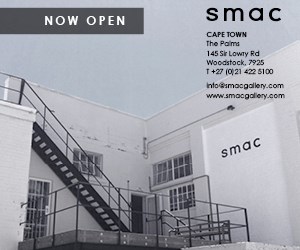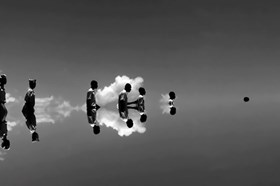cape reviews
Student Review: Between Subject and Object
Various Artists at Michaelis Gallery
By Anja de Klerk08 August - 30 August. 0 Comment(s)
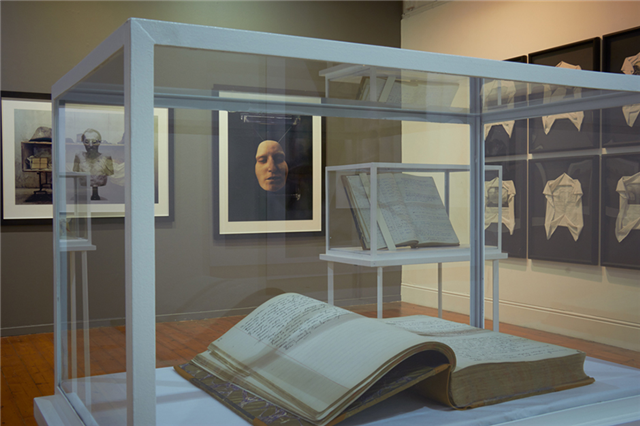
Kathryn Smith
Installation view: Between Subject and Object,
.
Photograph
.
Curators Josephine Higgins, Kathryn Smith and Penny Siopis’ sensitively constructed exhibition ‘Between Subject & Object, human remains at the interface of art and science’ presents us with the wide spectrum of subjects and objects implicated in the processes of classification, preparation, imaging, display and spectatorship of the deceased human body. The exhibition relies on and explores the historical relation between photography and death, raises questions around representation and knowledge, and offers curious and poignant objects of contemplation drawn from both Stellenbosch University’s Morphology Museum and UCT’s Pathology Learning Centre. The sensitivity and consideration with which the show has been approached allows for a large range of responses varying from the effective to the affective and the visceral. My own response draws from an embodied engagement with works of art and artifacts.
art events calendar
VIEW FULL CALENDARbuy art prints
edition of 60: R6,000.00
About Editions for ArtThrob
Outstanding prints by top South African artists. Your chance to purchase SA art at affordable prices.
FIND OUT MORE Editions for artthrob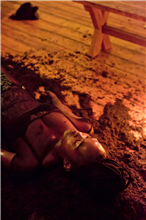
Paris Brummer
Performance documentation: Inzilo: ngihlahla kwa bafileyo
Photograph
On the opening night of the exhibition, amongst this arresting collection of largely photographic works and curious artifacts on display I found myself peering through a large crowd in an attempt to view Buhlebezwe Siwani’s performance Inzilo: ngihlahla kwa bafileyo (A time of mourning: I live with the dead) which together with Igshaan Adams’ Please Remember II is one of two performances on the exhibition programme. I caught fragments of a dark female body frantically digging into a mound of soil installed in one of the smaller rooms in the gallery. In contrast to the photographic, video and object-based works and artifacts, which I could access with relative ease, this work resisted and begged a more concerted interpretative effort.
According to the exhibition text and a few words exchanged with Siwani, she occupies a liminal position as she practices both as a Zulu sangoma and as an artist - she is currently reading for her MA in Fine Art at UCT. As sangoma she has a special relation to the dead and is subsequently not allowed to participate in contemporary Zulu private mourning or public burial rituals. Although she has privileged access to the dead and mediates between those alive and deceased this status prohibits her from the very human act of mourning, of saying goodbye and of acknowledging loss and sorrow. Mourning and burial are outside the accepted register of sangoma practices. Siwani’s hybrid status as artist-sangoma-student however affords her some creative grace and the possibility of a more flexible and in-between subjectivity, which she explores energetically in Inzilo. The small exhibition room in the Michaelis galleries allocated to this performance becomes an alternative ritual space where the mind and materiality of both the artist and the spectator are called upon to join in a new and very personal narrative of temporal transformation, mourning and burial.
I had a second chance to view the performance and was intermittently transfixed, transported and self-conscious of my own pale, western position as viewer of Siwani’s performance. The artist turns her back to the audience, lights a candle and peels off her everyday art-campus garb. She starts to chant and uses her limbs as instruments while a small TV screen set on a wooden bench transmits footage of: a traditional Zulu ritual (providing the background beat to her movements); advertisements for high-end vehicles; a game show and money being dished out by rappers. This makes for the banal life-goes-on backdrop against which Siwani articulates her actions. She mounts a stack of six mattresses, while reciting the Lord’s Prayer in Zulu, puts on a sheer black dress embellished with black mourning buttons, which becomes an acoustic augmentation to her body as instrument. She carefully folds a textured leopard print cloth into a triangular pillow, which becomes a cautiously balanced headdress. The buttons beat out their own rhythm and follow Siwani down to a mound of earth where she scrambles, mole-like and anxious as if birth and death descend on her simultaneously. Her body, the dress and soil become intertwined in this preparation for burial and I imagine myself underground amongst musky dark earth with blind subterranean creatures that are comfortable with the decaying and dead. She reaches for water and cleanses her face and arms and then reaches for holy oil to rub onto her body. The soil is rearranged and Siwani finds a place to rest. She has finally buried herself above ground. We are all inside the inverted grave breathing quietly, uncomfortably. I wonder where the animated force has gone and where we have we arrived? We, the small group of spectators remain standing. We are both necessary and burdensome; we are Siwani’s allies and exoticisers.
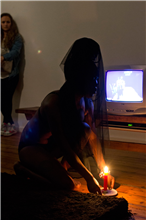
Paris Brummer
Performance documentation: Inzilo: ngihlahla kwa bafileyo
Photograph
On stepping out of the immediate experience of the performance and its transportative, compelling effect – I become curious about the three staged performance documentation photographs displayed on the far wall of the space. They were clearly made within the room in which they were displayed, but function in a different visual register. One which I am not sure complements the performance process, its content, or its installation components. Surely the weight of the residual post-performance materials, especially the mound of earth, bearing the imprint of Siwani’s body, is evidence enough of what occurred in the space? Both these materials and the photographs are works that can function on their own, and in different contexts.
I continue to wonder about my own relation to Inzilo as an onlooker and to what degree it conforms to the traditional performer-audience roles – including the desire to be looked at and to gaze upon. Although Siwani clearly occupies a fascinating artistic position, the structure of her performance sets up a very traditional spectator-performer relationship that does not equal the richness of its content. I am curious as to how she will challenge such normative subject positions in her future work and trust that she will do so with success.
‘Between Subject & Object’ has allowed me to reflect on my own vulnerability and thingness and urges me to reconsider the sanctity of every other, of every body. This exhibition offers those visitors who are willing to break the surface of their own interpretative index a rich experience worth more than one visit.
With thanks to Phendu Sibisi

